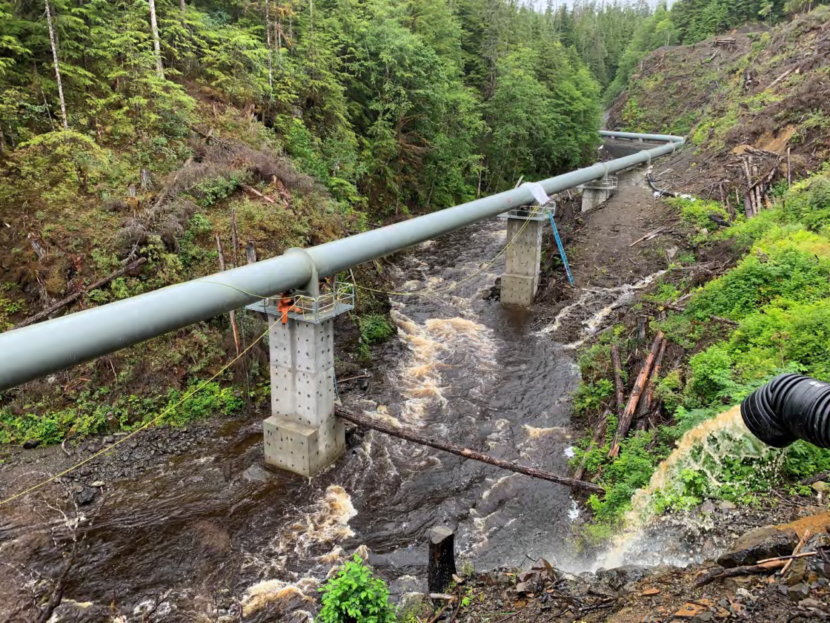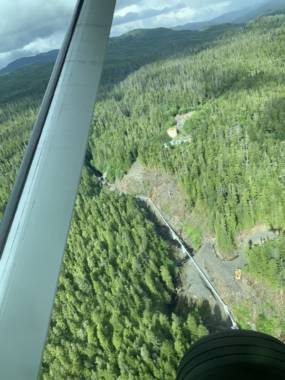
A new hydroelectric plant in Kake means the Kupreanof Island village will no longer have to rely solely on diesel generators for its electricity. The multi-million dollar Gunnuk Creek hydro project came online earlier this fall, and its proponents hope it will lower the cost of energy and bring the remote community one step closer to energy independence.
Residents of Kake have been experiencing intermittent power outages this fall as the Gunnuk Creek plant comes online. That’s all part of normal growing pains, says Jodi Mitchell, the CEO and General Manager of the Inside Passage Electric Cooperative, or IPEC. The nonprofit provides electricity to a handful of Southeast Alaska towns.
“When you build a new generation project in a remote village, you don’t just turn it on like you just plug in a new appliance,” Mitchell said. “You have to do a lot of adjustments and tweaking, basically to optimize the hydro output and minimize the diesel output.”
Aside from a small solar project, Kake relies on diesel generators for electricity. Since the Gunnuk Creek hydro project was turned on in September, it’s saved the town 2,500 gallons of diesel fuel. IPEC will still rely on diesel generators during dry times and as a backup source of electricity. But Mitchell said that at a minimum, the plant will cut diesel consumption in half over time. And hopefully that will translate to a reduction in rates.
“The less fuel we have to consume, that’s the savings that gets passed onto the customer,” she said.
A quest for more affordable energy is at the heart of Kake’s exploration of renewables like solar, biomass heating and now hydro. The cost of living in rural Alaska is high, and residential electricity rates in Kake are more than double the national average.
“We’re paying too much for electricity and heating,” president of Kake’s tribal government, the Organized Village of Kake, Joel Jackson, said. He and other community leaders worked with IPEC during the project’s planning stages. “There’s no silver bullet that will sustain us off the grid. But I think using a couple different things as we move forward will lessen the cost of living here.”
Whether this new plant will translate to lower rates is complicated for a variety of reasons. For one, IPEC’s rates are based on sales. The more electricity they sell, the lower their rates are, so if enough residents implement energy saving measures like installing LED lighting or energy-efficient appliances, their rates may actually go up. Also, because IPEC serves multiple communities, any savings from the hydro would be distributed throughout the region.

And residential customers benefit from something called power cost equalization, a state subsidy that helps offset the cost of energy. As IPEC’s costs go down, so do the state subsidies. But that program doesn’t include schools, businesses and churches, Mitchell says, so that could translate to lower prices for goods and services.
“The goal there is if we can reduce rates to those entities, they can provide more jobs. It will spur economic development in our communities,” Mitchell said.
IPEC paid for the bulk of the nearly $9 million project with state and federal grant funds. The dam was already in place, built by the Army Corps of Engineers in 2007 to help secure Kake’s water supply. IPEC constructed a penstock and a powerhouse, and Jackson expressed concern about the possible impact of this new construction on the salmon runs in Gunnuk Creek.
“There’s always negative sides to things and of course, you know, it’s a fish stream, so I hope that don’t disturb the fish return in there,” he said.
The Alaska Department of Fish and Game conducted site visits as part of Gunnuk Creek’s permitting process, and their reports show limited-to-no impact on fish runs. Gunnuk Creek also supports a hatchery, and manager Ryan Schuman said the hydro plant will help them by providing additional sources of power and clean water.
“We have been working cooperatively with them throughout their project to provide help whenever we can,” he said. “On the other side of the coin, they have helped us with a great many things as we’ve been working to get our project up and online.”
IPEC’s Mitchell said the Gunnuk Creek project initially faced a healthy dose of skepticism in Kake, especially from people who still support a cross-island intertie to Petersburg’s electrical grid. And she says that could still happen in the future, but she doesn’t think the nearly $70 million for the project will be available anytime soon because state and federal grant funds for renewable energy are harder to come by than in the past.
“I don’t see that there’s anything in the works that’s going to make the intertie project any easier or cheaper at this point,” she said.
Gunnuk Creek is one of around 20 hydro projects across Southeast Alaska. It’s IPEC’s third hydroelectric project, and there’s a fourth in the works in Angoon.
